PBAT/PLA-Based Electrospun Nanofibrous Protective Clothes with Superhydrophobicity, Permeability, and Thermal Insulation Characteristics for Individuals with Disabilities
Abstract
1. Introduction
2. Experiments
2.1. Materials and Methods
2.2. Preparation of PBAT/PLA-Based Multifunctional Electrospun Fabrics
2.3. Production of Electrospun Nanofiber Fabrics
2.4. Characterizations
3. Results and Discussion
3.1. Preparation of Superhydrophobic Electrospun Nanofibrous Fabrics
3.2. Thermal Analysis
3.3. X-ray Diffractometry (XRD)
3.4. Wettability Study
3.5. Measurements of Breathability and Hydrostatic Pressure
3.6. Heat Reflector
3.7. Mechanical Strength
4. Conclusions
Author Contributions
Funding
Institutional Review Board Statement
Data Availability Statement
Acknowledgments
Conflicts of Interest
References
- Zhang, T.; Han, W.; Zhang, C.; Weng, Y. Effect of chain extender and light stabilizer on the weathering resistance of PBAT/PLA blend films prepared by extrusion blowing. Polym. Degrad. Stab. 2021, 183, 109455. [Google Scholar] [CrossRef]
- Khan, H.; Kaur, S.; Baldwin, T.C.; Radecka, I.; Jiang, G.; Bretz, I.; Duale, K.; Adamus, G.; Kowalczuk, M. Effective Control against Broadleaf Weed Species Provided by Biodegradable PBAT/PLA Mulch Film Embedded with the Herbicide 2-Methyl-4-Chlorophenoxyacetic Acid (MCPA). ACS Sustain. Chem. Eng. 2020, 8, 5360–5370. [Google Scholar] [CrossRef]
- Aijaz, M.O.; Yang, S.B.; Karim, M.R.; Othman, M.H.D.; Alnaser, I.A. Preparation and Characterization of Poly(Lactic Acid)/Poly (ethylene glycol)-Poly(propyl glycol)-Poly(ethylene glycol) Blended Nanofiber Membranes for Fog Collection. Membranes 2023, 13, 32. [Google Scholar] [CrossRef] [PubMed]
- Jiang, G.; Li, H.; Wang, F. Structure of PBAT/PPC blends prepared by in-situ reactive compatibilization and properties of their blowing films. Mater. Today Commun. 2021, 27, 102215. [Google Scholar] [CrossRef]
- Jian, J.; Xiangbin, Z.; Xianbo, H. An overview on synthesis, properties and applications of poly(butylene-adipate-co-terephthalate)–PBAT. Adv. Ind. Eng. Polym. Res. 2020, 3, 19–26. [Google Scholar] [CrossRef]
- Xie, J.; Wang, Z.; Zhao, Q.; Yang, Y.; Xu, J.; Waterhouse, G.I.N.; Zhang, K.; Li, S.; Jin, P.; Jin, G. Scale-Up Fabrication of Biodegradable Poly(butylene adipate-co-terephthalate)/Organophilic-Clay Nanocomposite Films for Potential Packaging Applications. ACS Omega 2018, 3, 1187–1196. [Google Scholar] [CrossRef] [PubMed]
- Camani, P.H.; Souza, A.G.; Barbosa, R.F.S.; Zanini, N.C.; Mulinari, D.R.; Rosa, D.S. Comprehensive insight into surfactant modified-PBAT physico-chemical and biodegradability properties. Chemosphere 2021, 269, 128708. [Google Scholar] [CrossRef] [PubMed]
- Li, Y.; Zhao, L.; Changyu, H.; Yancun, Y. Biodegradable blends of poly (butylene adipate-co-terephthalate) and stereocomplex polylactide with enhanced rheological, mechanical properties and thermal resistance. Colloid Polym. Sci. 2020, 298, 463–475. [Google Scholar] [CrossRef]
- Wei, X.; Ren, L.; Sun, Y.; Zhang, X.; Guan, X.; Zhang, M.; Zhang, H. Sustainable composites from biodegradable poly (butylene succinate) modified with thermoplastic starch and poly (butylene adipate-co-terephthalate): Preparation and performance. New J. Chem. 2021, 45, 17384–17397. [Google Scholar] [CrossRef]
- Rocha, D.B.; de Carvalho, J.S.; de Oliveira, S.A.; Rosa, D.D.S. A new approach for flexible PBAT/PLA/CaCO3 films into agriculture. J. Appl. Polym. Sci. 2018, 135, 46660. [Google Scholar] [CrossRef]
- Girdthep, S.; Worajittiphon, P.; Leejarkpai, T.; Molloy, R.; Punyodom, W. Effect of silver-loaded kaolinite on real ageing, hydrolytic degradation, and biodegradation of composite blown films based on poly(lactic acid) and poly(butylene adipate-co-terephthalate). Eur. Polym. J. 2016, 82, 244–259. [Google Scholar] [CrossRef]
- Titone, V.; La Mantia, F.P.; Mistretta, M.C. The Effect of Calcium Carbonate on the Photo-Oxidative Behavior of Poly(butyleneadipate-co-terephthalate). Macromol. Mater. Eng. 2020, 305, 2000358. [Google Scholar] [CrossRef]
- Zhao, H.; Yu, Y.; Han, C.; Liu, Q.; Liu, H.; Zhou, G.; Xu, M. Improving the stereocomplexation and toughness of poly (L-lactic acid)/poly (D-lactic acid) blends via melt blending with ethylene/methyl acrylate/glycidyl methacrylate terpolymer. J. Macromol. Sci. Part A 2021, 58, 419–430. [Google Scholar] [CrossRef]
- Chang, W.-M.; Zhao, Y.-X.; Guo, R.; Wang, Q.; Gu, X. Design and Study of Clothing Structure for People with Limb Disabilities. J. Fiber Bioeng. Inform. 2009, 2, 62–67. [Google Scholar] [CrossRef]
- Kosinski, K.; Orzada, B.T.; Kim, H.-S. Commercialization of Adaptive Clothing: Toward a Movement of Inclusive Design; Iowa State University Digital Press: Ames, IA, USA, 2018. [Google Scholar]
- Sadretdinova, N.; Bereznenko, S.; Bilotska, L.; Szafrańska, H.; Pawlowa, M. Designing of casual wear for wheelchair users. Commun. Dev. Assem. Text. Prod. 2022, 3, 180–190. [Google Scholar] [CrossRef]
- Dana, A.N.; Bauman, W.A. Bacteriology of pressure ulcers in individuals with spinal cord injury: What we know and what we should know. J. Spinal Cord Med. 2015, 38, 147–160. [Google Scholar] [CrossRef]
- Aijaz, M.O.; Alnaser, I.A.; Farooq, I.; Siddiqui, M.I.H.; Yang, S.B.; Shakeel, F.; Karim, M.R. Developing novel multifunctional protective clothes for disabled individuals using bio-based electrospun nanofibrous membranes. Int. J. Biol. Macromol. 2024, 275, 133598. [Google Scholar] [CrossRef]
- Aijaz, M.O.; Alnaser, I.A.; Farooq, I.; Siddiqui, M.I.H.; Yang, S.B.; Shakeel, F.; Karim, M.R. Electrospun bio-polymeric nanofibrous membrane for membrane distillation desalination application. Desalination 2024, 586, 117825. [Google Scholar] [CrossRef]
- Karim, M.R.; Al-Ahmari, A.; Dar, M.; Aijaz, M.; Mollah, M.; Ajayan, P.; Yeum, J.; Kim, K.-S. Conducting and Biopolymer Based Electrospun Nanofiber Membranes for Wound Healing Applications. Curr. Nanosci. 2016, 12, 220–227. [Google Scholar] [CrossRef]
- Tabatabaei, S.H.; Carreau, P.J.; Ajji, A. Microporous membranes obtained from polypropylene blend films by stretching. J. Membr. Sci. 2008, 325, 772–782. [Google Scholar] [CrossRef]
- Aijaz, M.O.; Karim, M.R.; Othman, M.H.D.; Samad, U.A. Anti-fouling/wetting electrospun nanofibrous membranes for membrane distillation desalination: A comprehensive review. Desalination 2023, 553, 116475. [Google Scholar] [CrossRef]
- Yu, B.; Han, J.; He, X.; Xu, G.; Ding, X. Effects of Tourmaline Particles on Structure and Properties of Polypropylene Filtration Melt-Blown Nonwoven Electrets. J. Macromol. Sci. Part B 2012, 51, 619–629. [Google Scholar] [CrossRef]
- Aijaz, M.O.; Karim, M.R.; Alharbi, H.F.; Alharthi, N.H. Novel optimised highly aligned electrospun PEI-PAN nanofibre mats with excellent wettability. Polymer 2019, 180, 121665. [Google Scholar] [CrossRef]
- Ra, Y.; Kim, J.W.; You, I.; Jang, S.; Cho, S.; Gwon, G.; Kam, D.; Lee, D.; Ahmad, A.; Karim, M.R.; et al. Direct electrospinning of reconstructable PVDF-TrFE nanofibrous mat onto conductive cement nanocomposite for triboelectricity-assisted net zero energy structure. Chem. Eng. J. 2024, 485, 149662. [Google Scholar] [CrossRef]
- Wang, X.; Ding, B.; Sun, G.; Wang, M.; Yu, J. Electro-spinning/netting: A strategy for the fabrication of three-dimensional polymer nano-fiber/nets. Prog. Mater. Sci. 2013, 58, 1173–1243. [Google Scholar] [CrossRef] [PubMed]
- Hussain, A.; Mohamed, M.M.; Aijaz, M.O.; Karim, M.R.; Aziz, M.A. Electrospun PEI/PAN membrane for advanced Zn ion hybrid supercapacitors. J. Energy Storage 2024, 84, 110974. [Google Scholar] [CrossRef]
- Lee, S.; Obendorf, S.K. Use of Electrospun Nanofiber Web for Protective Textile Materials as Barriers to Liquid Penetration. Text. Res. J. 2007, 77, 696–702. [Google Scholar] [CrossRef]
- Baji, A.; Agarwal, K.; Oopath, S.V. Emerging Developments in the Use of Electrospun Fibers and Membranes for Protective Clothing Applications. Polymers 2020, 12, 492. [Google Scholar] [CrossRef]
- Jiang, G.; Luo, L.; Tan, L.; Wang, J.; Zhang, S.; Zhang, F.; Jin, J. Microsphere-Fiber Interpenetrated Superhydrophobic PVDF Microporous Membranes with Improved Waterproof and Breathable Performance. ACS Appl. Mater. Interfaces 2018, 10, 28210–28218. [Google Scholar] [CrossRef]
- Jin, C.; Gong, X.; Jiao, W.; Yin, X.; Yu, J.; Zhang, S.; Ding, B. Superhydrophobic polyvinylidene fluoride nanofibrous membranes with stable hierarchical structures for protective textiles. Compos. Commun. 2023, 38, 101500. [Google Scholar] [CrossRef]
- Gu, Y.; Wu, J.; Hu, M.; Pi, H.; Wang, R.; Zhang, X. Polylactic acid based Janus membranes with asymmetric wettability for directional moisture transport with enhanced UV protective capabilities. RSC Adv. 2021, 12, 32–41. [Google Scholar] [CrossRef]
- Herrero-Herrero, M.; Gómez-Tejedor, J.-A.; Vallés-Lluch, A. PLA/PCL electrospun membranes of tailored fibres diameter as drug delivery systems. Eur. Polym. J. 2018, 99, 445–455. [Google Scholar] [CrossRef]
- Ciarfaglia, N.; Laezza, A.; Lods, L.; Lonjon, A.; Dandurand, J.; Pepe, A.; Bochicchio, B. Thermal and dynamic mechanical behavior of poly(lactic acid)(PLA)-based electrospun scaffolds for tissue engineering. J. Appl. Polym. Sci. 2021, 138, 51313. [Google Scholar] [CrossRef]
- Hajikhani, M.; Emam-Djomeh, Z.; Askari, G. Fabrication and characterization of mucoadhesive bioplastic patch via coaxial polylactic acid (PLA) based electrospun nanofibers with antimicrobial and wound healing application. Int. J. Biol. Macromol. 2021, 172, 143–153. [Google Scholar] [CrossRef] [PubMed]
- Aijaz, M.O.; Yang, S.B.; Karim, M.R.; Alnaser, I.A.; Alahmari, A.D.; Almubaddel, F.S.; Assaifan, A.K. Preparation and Characterization omf Electrospun Poly(lactic acid)/Poly(ethylene glycol)–b–poly(propylene glycol)–b–poly(ethylene glycol)/Silicon Dioxide Nanofibrous Adsorbents for Selective Copper (II) Ions Removal from Wastewater. Membranes 2023, 13, 54. [Google Scholar] [CrossRef]
- Gorji, M.; Karimi, M.; Nasheroahkam, S. Electrospun PU/P(AMPS-GO) nanofibrous membrane with dual-mode hydrophobic–hydrophilic properties for protective clothing applications. J. Ind. Text. 2018, 47, 1166–1184. [Google Scholar] [CrossRef]
- Madheswaran, D.; Sivan, M.; Hauzerova, S.; Kostakova, E.K.; Jencova, V.; Valtera, J.; Behalek, L.; Mullerova, J.; Nguyen, N.H.A.; Capek, L.; et al. Continuous fabrication of braided composite nanofibrous surgical yarns using advanced AC electrospinning and braiding technology. Compos. Commun. 2024, 48, 101932. [Google Scholar] [CrossRef]
- Moustafa, H.; El Kissi, N.; Abou-Kandil, A.I.; Abdel-Aziz, M.S.; Dufresne, A. PLA/PBAT Bionanocomposites with Antimicrobial Natural Rosin for Green Packaging. ACS Appl. Mater. Interfaces 2017, 9, 20132–20141. [Google Scholar] [CrossRef]
- Wang, L.F.; Rhim, J.W.; Hong, S.I. Preparation of poly(lactide)/poly(butylene adipate-co-terephthalate) blend films using a solvent casting method and their food packaging application. LWT-Food Sci. Technol. 2016, 68, 454–461. [Google Scholar] [CrossRef]
- Girdthep, S.; Worajittiphon, P.; Molloy, R.; Lumyong, S.; Leejarkpai, T.; Punyodom, W. Biodegradable nanocomposite blown films based on poly(lactic acid) containing silver-loaded kaolinite: A route to controlling moisture barrier property and silver ion release with a prediction of extended shelf life of dried longan. Polymer 2014, 55, 6776–6788. [Google Scholar] [CrossRef]
- Khatsee, S.; Daranarong, D.; Punyodom, W.; Worajittiphon, P. Electrospinning polymer blend of PLA and PBAT: Electrospinnability–solubility map and effect of polymer solution parameters toward application as antibiotic-carrier mats. J. Appl. Polym. Sci. 2018, 135, 46486. [Google Scholar] [CrossRef]
- Girdthep, S.; Worajittiphon, P.; Molloy, R.; Lumyong, S.; Leejarkpai, T.; Punyodom, W. Electrospun poly(lactic acid) (PLA)/poly(butylene adipate-co-terephthalate) (PBAT) nanofibers for the controlled release of cilostazol. Int. J. Biol. Macromol. 2021, 182, 333–342. [Google Scholar]
- de S. Rossin, A.R.; Caetano, J.; Zanella, H.G.; Bariccatti, R.A.; Gaffo, L.; Muniz, E.C.; Caetano, W.; Stolf, S.F.; Dragunski, D.C. Obtaining and characterization of PBAT/PLA fibers containing zinc phthalocyanine prepared by the electrospinning method. J. Therm. Anal. Calorim. 2021, 147, 4579–4587. [Google Scholar]
- Aijaz, M.O.; Karim, M.R.; Alnaser, I.A.; Siddiqui, M.I.H.; Assaifan, A.K. Silica NPs in PLA-Based Electrospun Nanofibrous Non-Woven Protective Fabrics with Dual Hydrophilicity/Hydrophobicity, Breathability, and Thermal Insulation Characteristics for Individuals with Disabilities. Polymers 2023, 15, 4139. [Google Scholar] [CrossRef]
- Yanilmaz, M.; Chen, C.; Zhang, X. Fabrication and characterization of SiO2/PVDF composite nanofiber-coated PP nonwoven separators for lithium-ion batteries. J. Polym. Sci. Part B Polym. Phys. 2013, 51, 1719–1726. [Google Scholar] [CrossRef]
- Ji, L.; Zhang, X. Ultrafine polyacrylonitrile/silica composite fibers via electrospinning. Mater. Lett. 2008, 62, 2161–2164. [Google Scholar] [CrossRef]
- Xiao, H.; Lu, W.; Yeh, J.-T. Crystallization behavior of fully biodegradable poly(lactic acid)/poly(butylene adipate-coterephthalate) blends. J. Appl. Polym. Sci. 2009, 112, 3754–3763. [Google Scholar] [CrossRef]
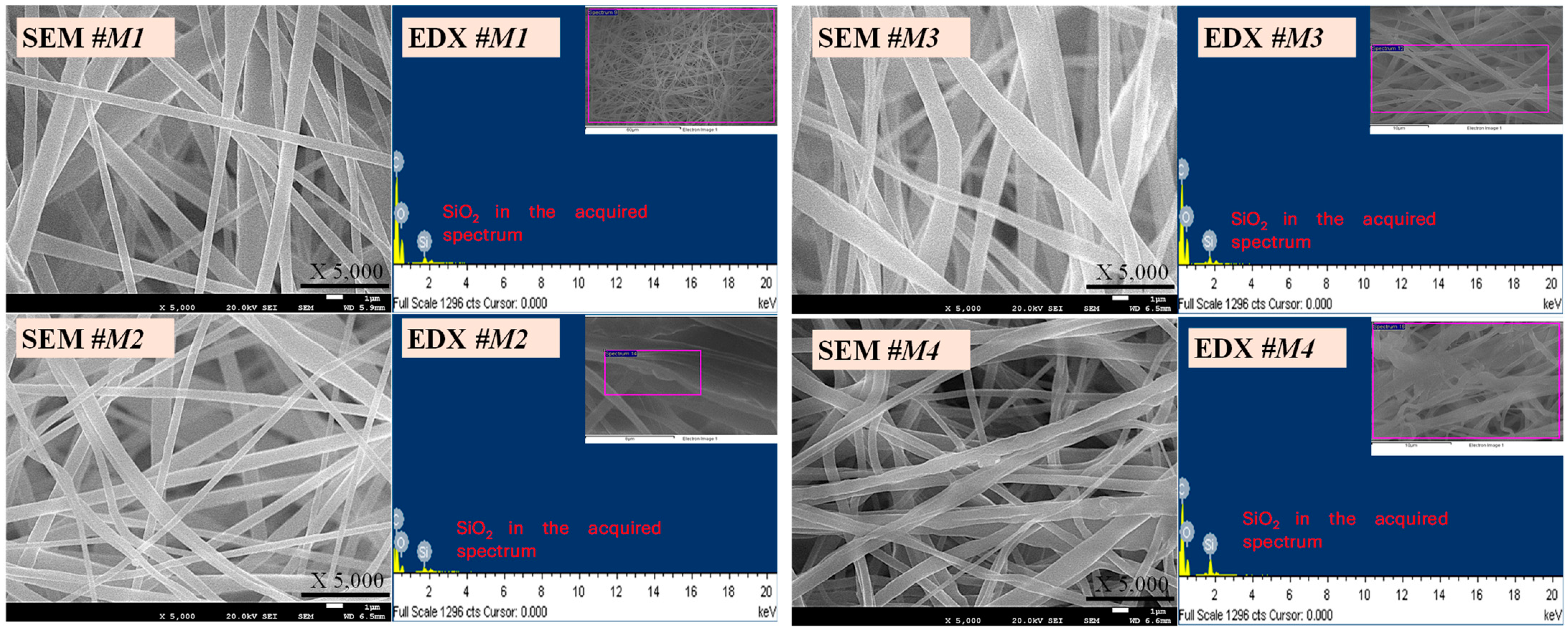
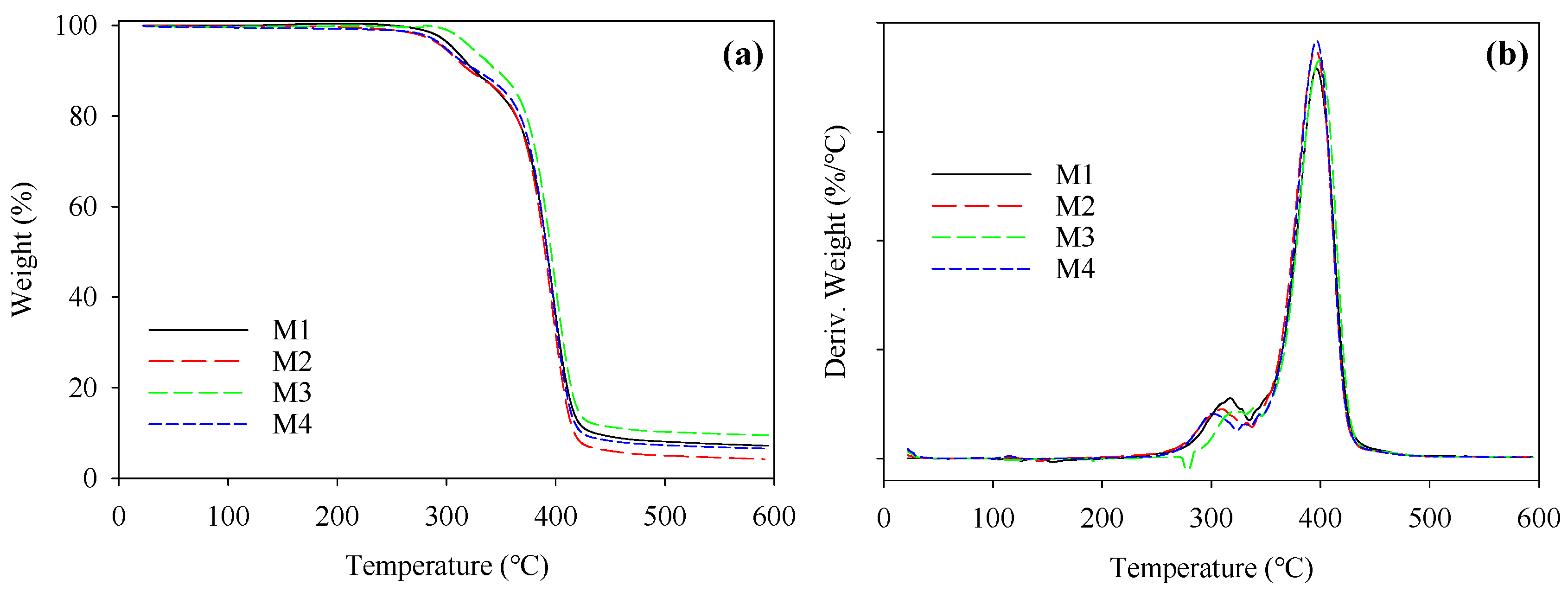
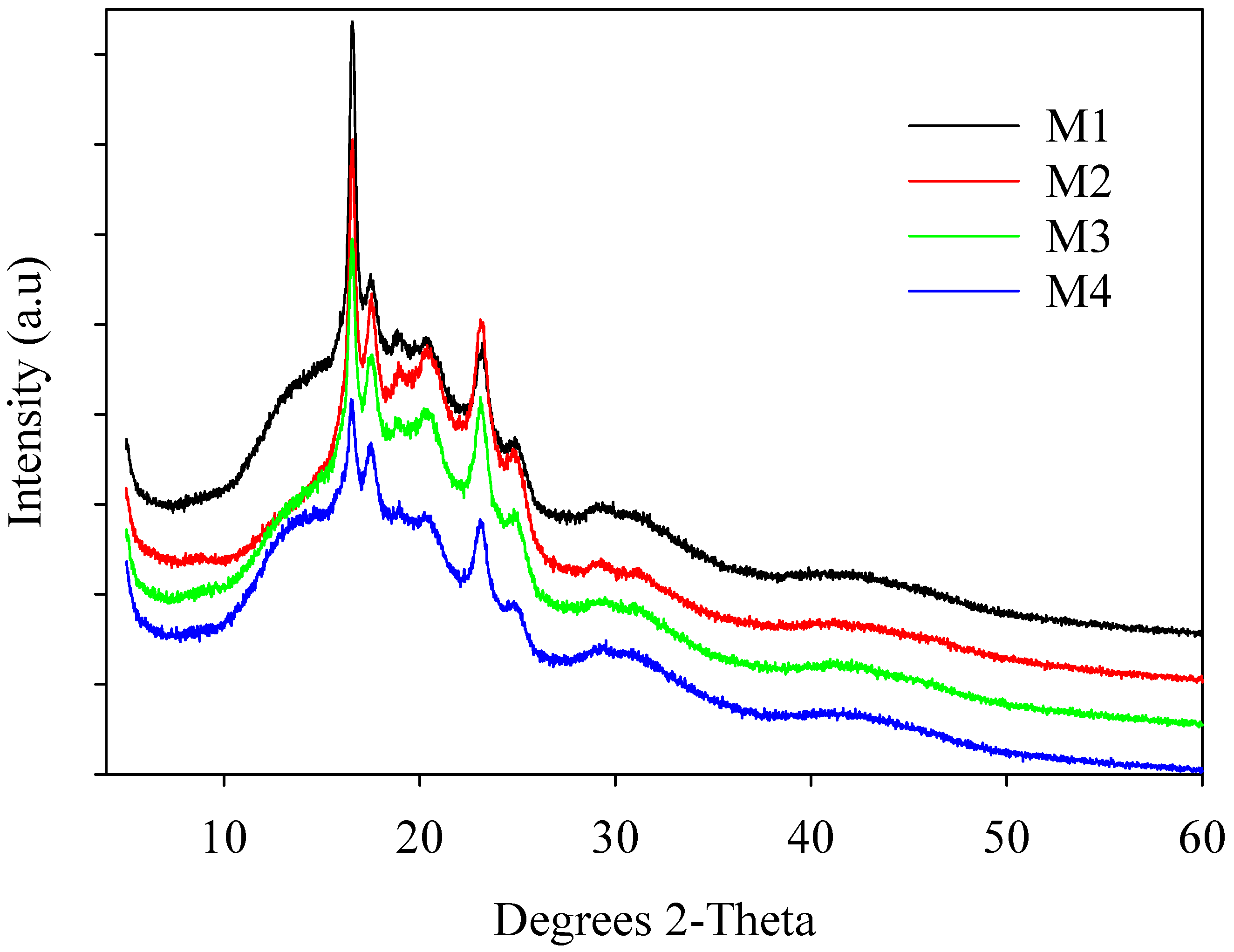
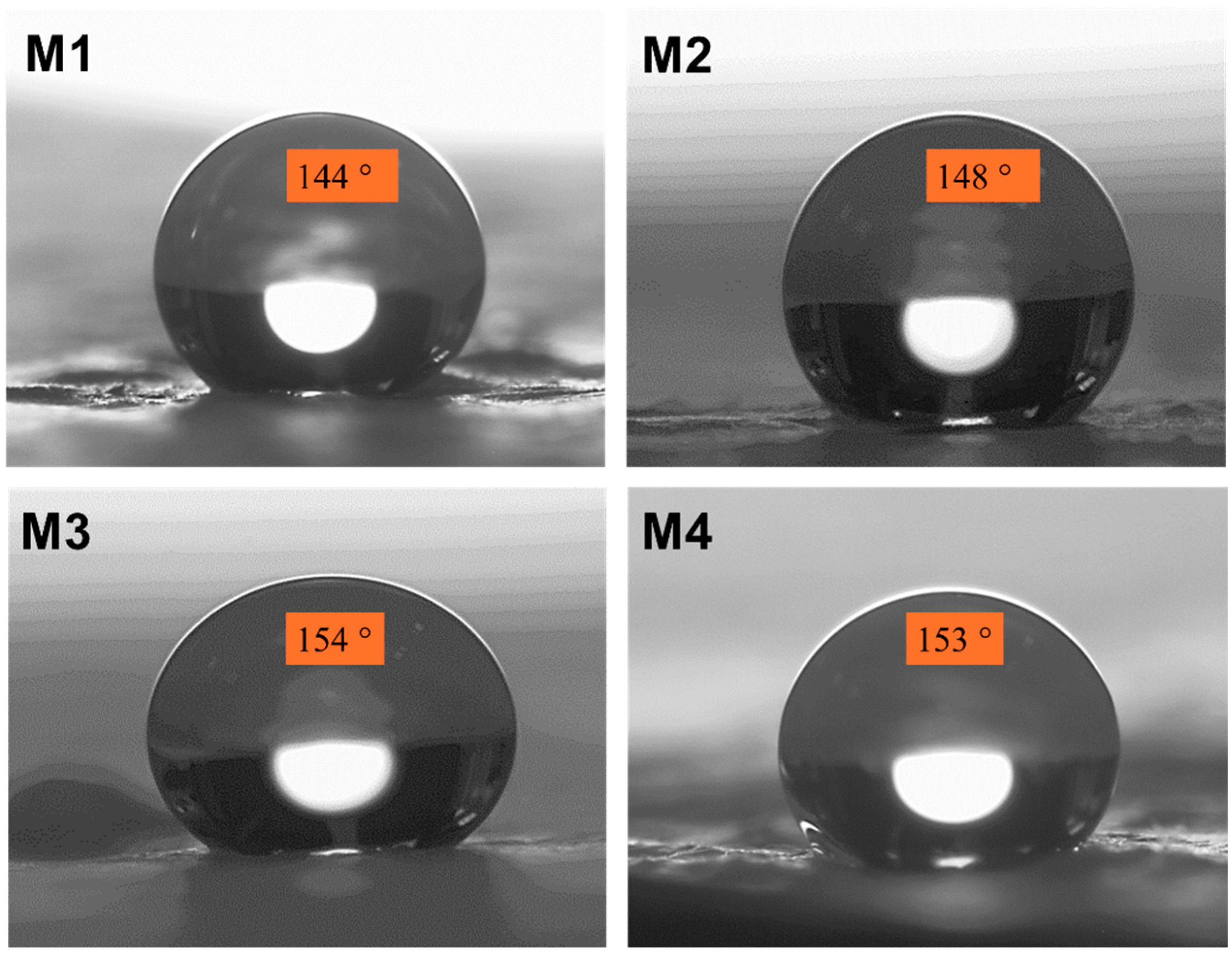
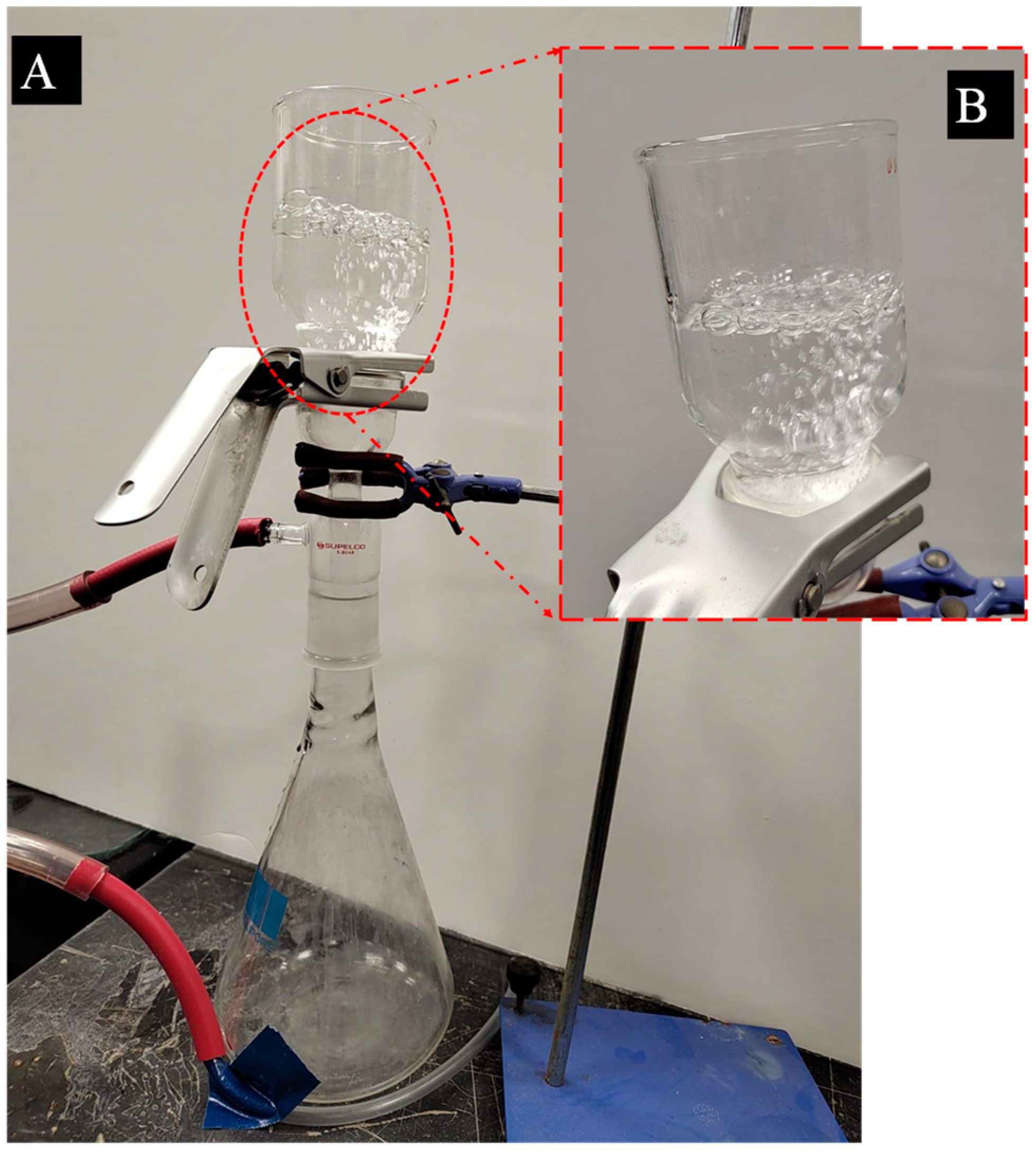
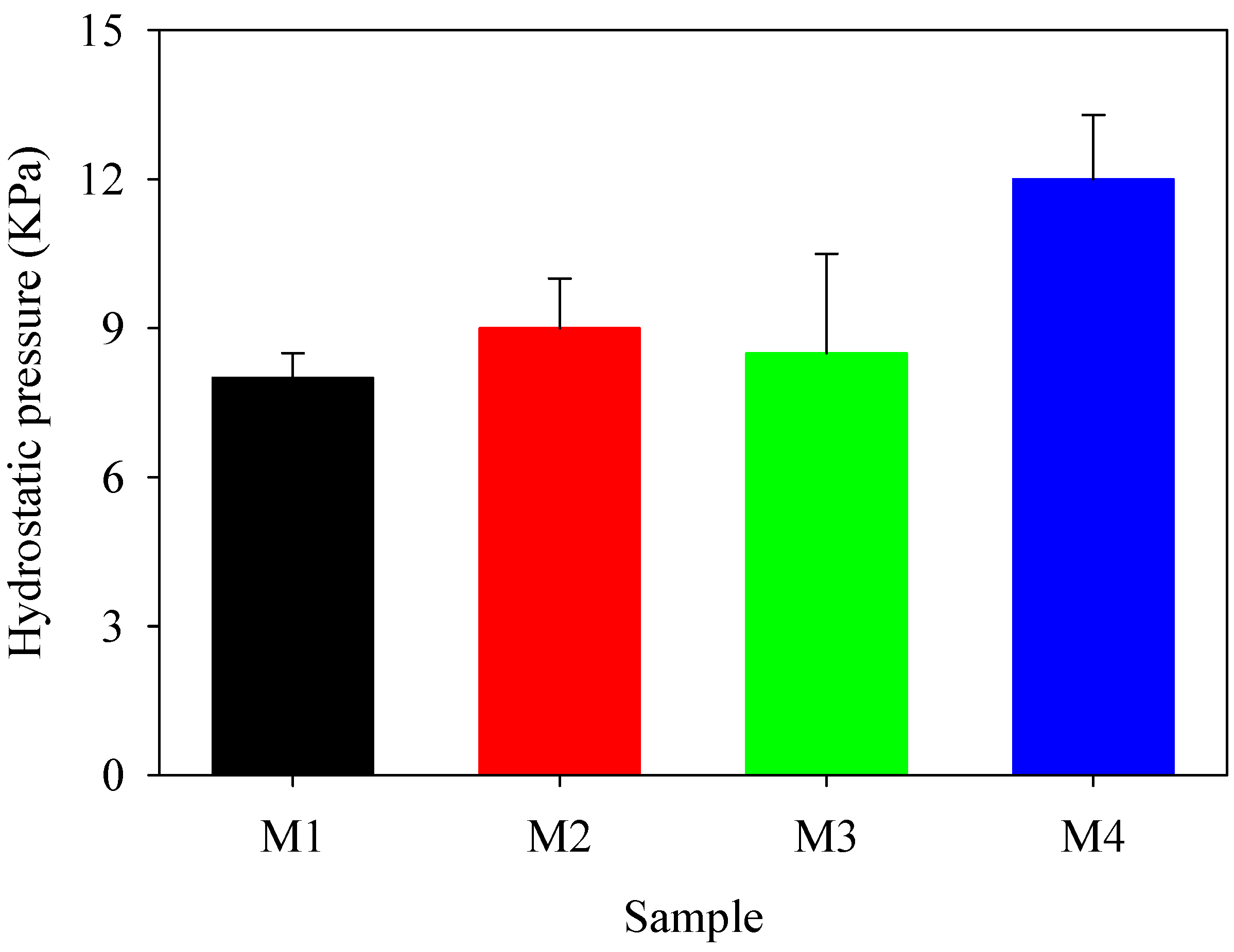
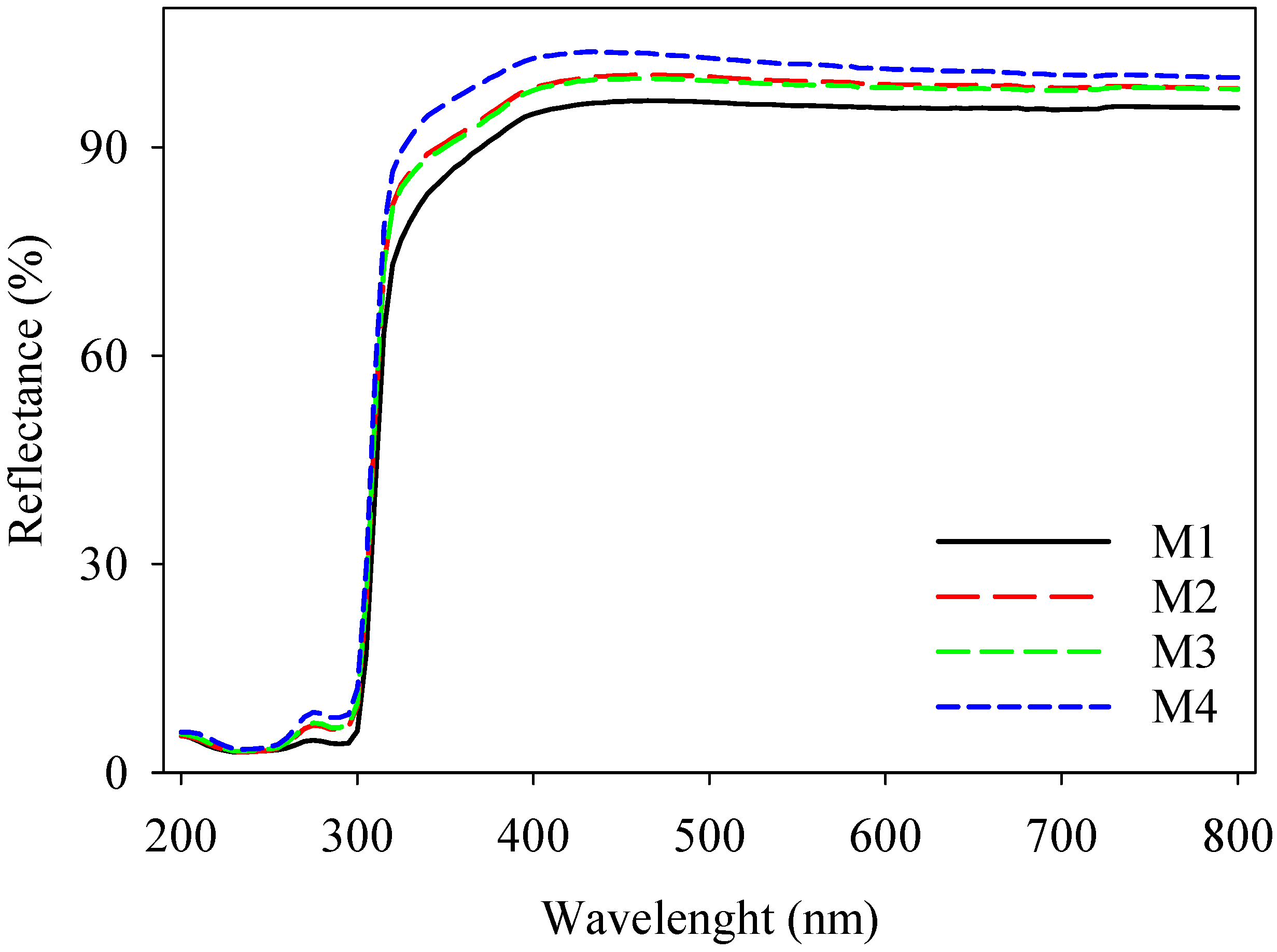

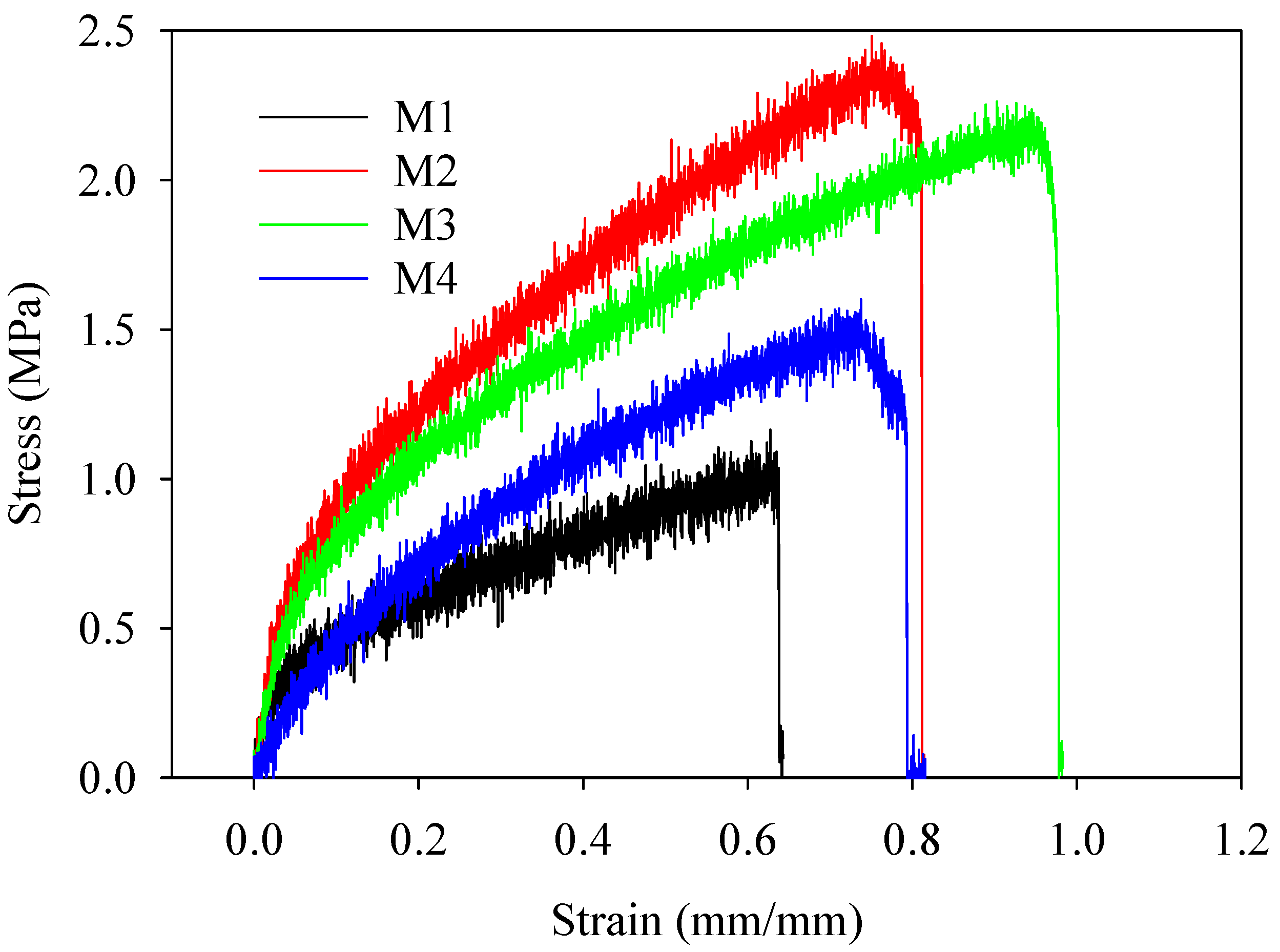
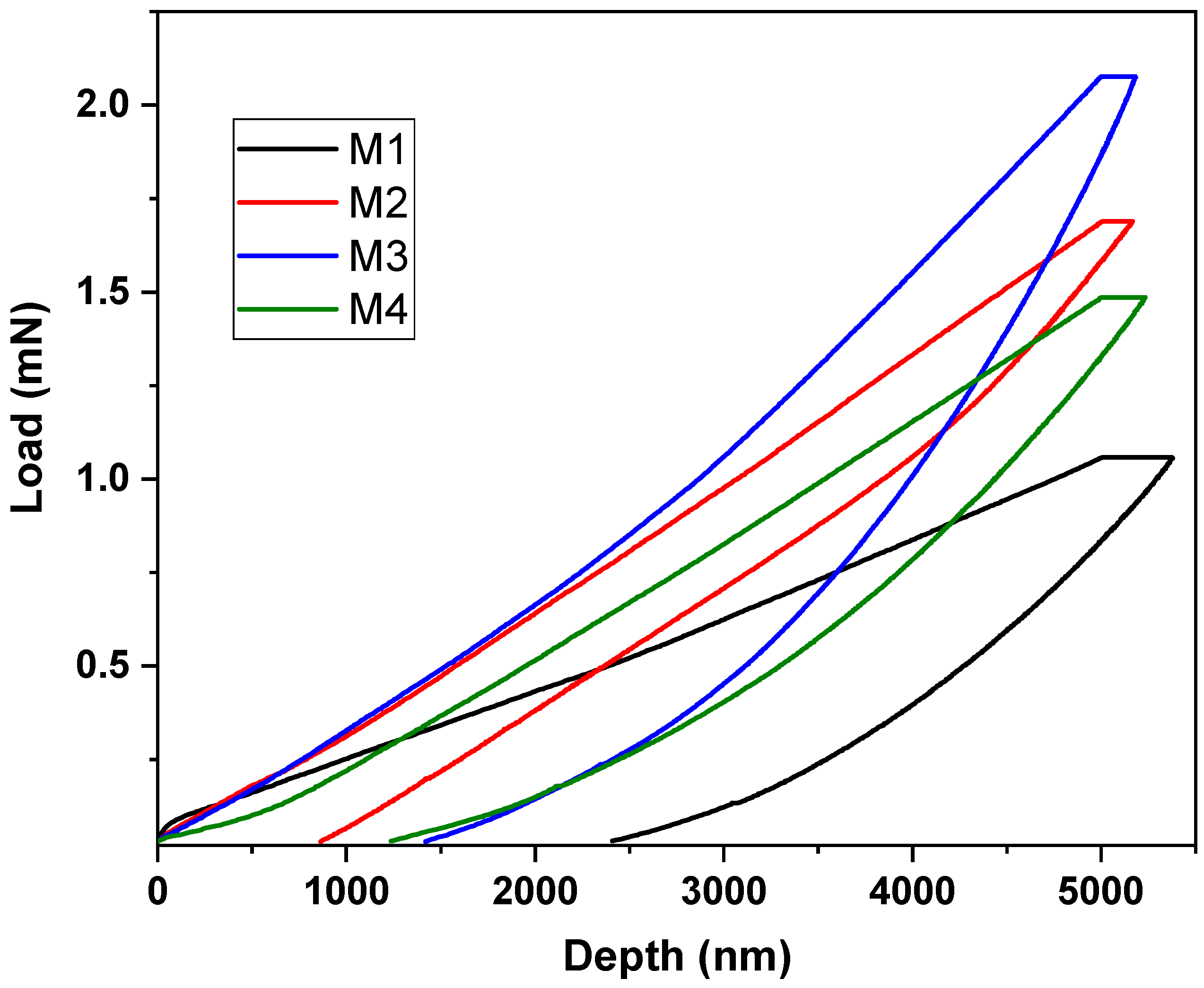

| Nanofibrous Electrospun Fabric Samples’ Codes | PBAT Concentration (% w/v) | PLA Concentration (% w/v) | SiO2 Concentration (% w/w) |
|---|---|---|---|
| M1 | 15 | 12 | 1 |
| M2 | 3 | ||
| M3 | 5 | ||
| M4 | 7 |
| Sample | Indentation Hardness (GPa) | Indentation Modulus (GPa) |
|---|---|---|
| M1 | 0.00199 | 0.0167 |
| M2 | 0.00347 | 0.0185 |
| M3 | 0.00370 | 0.0299 |
| M4 | 0.00180 | 0.0145 |
Disclaimer/Publisher’s Note: The statements, opinions and data contained in all publications are solely those of the individual author(s) and contributor(s) and not of MDPI and/or the editor(s). MDPI and/or the editor(s) disclaim responsibility for any injury to people or property resulting from any ideas, methods, instructions or products referred to in the content. |
© 2024 by the authors. Licensee MDPI, Basel, Switzerland. This article is an open access article distributed under the terms and conditions of the Creative Commons Attribution (CC BY) license (https://creativecommons.org/licenses/by/4.0/).
Share and Cite
Aijaz, M.O.; Abdus Samad, U.; Alnaser, I.A.; Siddiqui, M.I.H.; Assaifan, A.K.; Karim, M.R. PBAT/PLA-Based Electrospun Nanofibrous Protective Clothes with Superhydrophobicity, Permeability, and Thermal Insulation Characteristics for Individuals with Disabilities. Polymers 2024, 16, 2469. https://doi.org/10.3390/polym16172469
Aijaz MO, Abdus Samad U, Alnaser IA, Siddiqui MIH, Assaifan AK, Karim MR. PBAT/PLA-Based Electrospun Nanofibrous Protective Clothes with Superhydrophobicity, Permeability, and Thermal Insulation Characteristics for Individuals with Disabilities. Polymers. 2024; 16(17):2469. https://doi.org/10.3390/polym16172469
Chicago/Turabian StyleAijaz, Muhammad Omer, Ubair Abdus Samad, Ibrahim A. Alnaser, Md Irfanul Haque Siddiqui, Abdulaziz K. Assaifan, and Mohammad Rezaul Karim. 2024. "PBAT/PLA-Based Electrospun Nanofibrous Protective Clothes with Superhydrophobicity, Permeability, and Thermal Insulation Characteristics for Individuals with Disabilities" Polymers 16, no. 17: 2469. https://doi.org/10.3390/polym16172469
APA StyleAijaz, M. O., Abdus Samad, U., Alnaser, I. A., Siddiqui, M. I. H., Assaifan, A. K., & Karim, M. R. (2024). PBAT/PLA-Based Electrospun Nanofibrous Protective Clothes with Superhydrophobicity, Permeability, and Thermal Insulation Characteristics for Individuals with Disabilities. Polymers, 16(17), 2469. https://doi.org/10.3390/polym16172469










